Waste statistics - recycling of batteries and accumulators
Data extracted in December 2023
Planned article update: December 2024
Highlights
Close to one-half (48%) of the portable batteries and accumulators sold in the EU were collected for recycling in 2021. From 2009 to 2021, the collected amount doubled.
In 2021, 242 000 tonnes of portable batteries were sold in the EU. In the same year, 108 000 tonnes of used portable batteries were collected for recycling.
Portable batteries and accumulators collected for recycling, 2021
This article provides an overview of statistics on sales, collection and recycling of batteries and accumulators in the European Union and the EU Member States.
The overall objective of the Batteries Directive (Directive 2006/66/EC on portable batteries and accumulators) is to minimise the negative impact of batteries and accumulators on the environment, contributing to the protection, preservation and improvement of the quality of the environment. Therefore, waste batteries and accumulators should be collected and recycled; a high collection and recycling rate should be achieved to ensure a high level of environmental protection and material recovery.
Full article
Sales and collection of portable batteries and accumulators
Sales (products put on the market) and collection (waste collected) of portable batteries and accumulators from 2009 to 2021 are presented in Tables 1a and 1b, covering data for the European Union, the EU Member States and available EFTA countries. In 2021, around 242 000 tonnes of portable batteries and accumulators were put on the market (sales) in the EU, while around 108 000 tonnes of used portable batteries and accumulators were collected as recyclable waste. Thus, slightly less than half (48 %) of the average annual sales of portable batteries (calculated on the period 2018-2021) were collected for recycling in 2021.
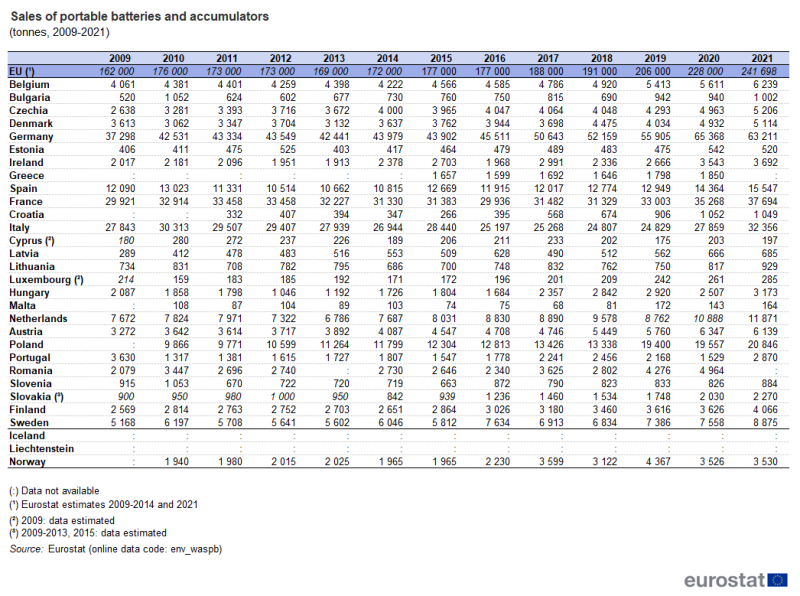
(tonnes)
Source: Eurostat (env_waspb)
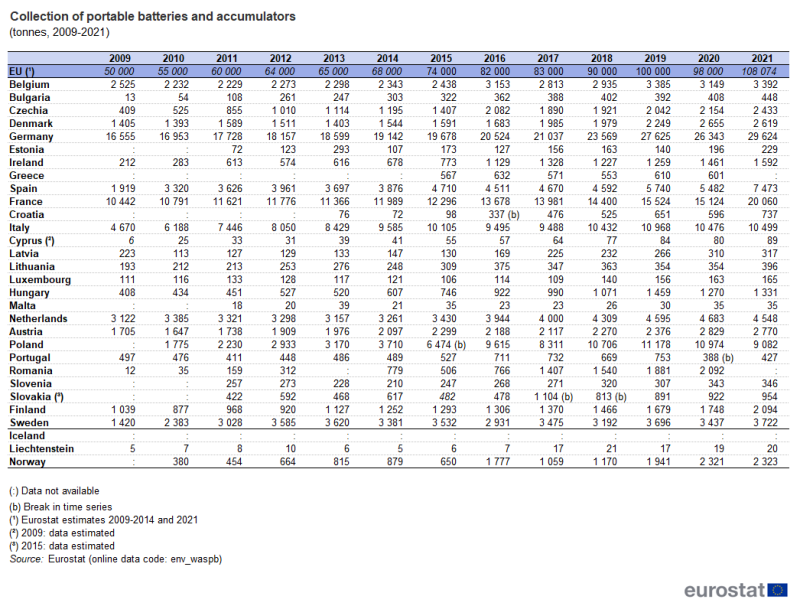
(tonnes)
Source: Eurostat (env_waspb)
The amount of portable batteries and accumulators put on the market varies strongly across the EU Member States, with sales in individual Member States ranging from 164 tonnes in Malta to more than 63 000 tonnes in Germany in 2021. Overall, country-specific sales have increased over the period from 2009 to 2021, with volumes increasing for most Member States. Only two Member States reported a decrease over this period.
The amount of waste portable batteries and accumulators, measured in tonnes, is lower than average sales over the last three years. Between 2009 and 2021, collection of waste batteries increased steadily in almost all Member States. There are only a few exceptions, where the data fluctuate around a slightly growing trend.
Figure 1 shows the development of the collection and sales of portable batteries and accumulators in the EU. The amount put on the market rose from 2009 to 2010, reaching 176 000 tonnes, before falling slightly to 169 000 tonnes in 2013. Steady growth followed from 2014 to 2018, before accelerating to 206 000 tonnes in 2019 and a new peak of 242 000 tonnes in 2021.
By contrast, the collection of waste batteries and accumulators in the EU has increased steadily since 2009. Starting from a level of around 50 000 tonnes in 2009, collection increased to around 108 000 tonnes by 2021.

(tonnes)
Source: Eurostat (env_waspb)
The 'Batteries Directive' defines targets for the collection rates of portable batteries and accumulators. The target for 2012 was a collection rate of 25 %, rising to 45 % by 2016. In 2021, 19 of the EU Member States recorded a collection rate of portable waste batteries of 45 % or more while another three reported collection rates in the range 40 % to 45 % (see Table 2). Collection rates are calculated based on the sales data in Table 1a and the collection data in Table 1b, as a ratio of the weight of the collected batteries in a reference year divided by the average of the weight of the batteries sold during the reference year and the previous two years.
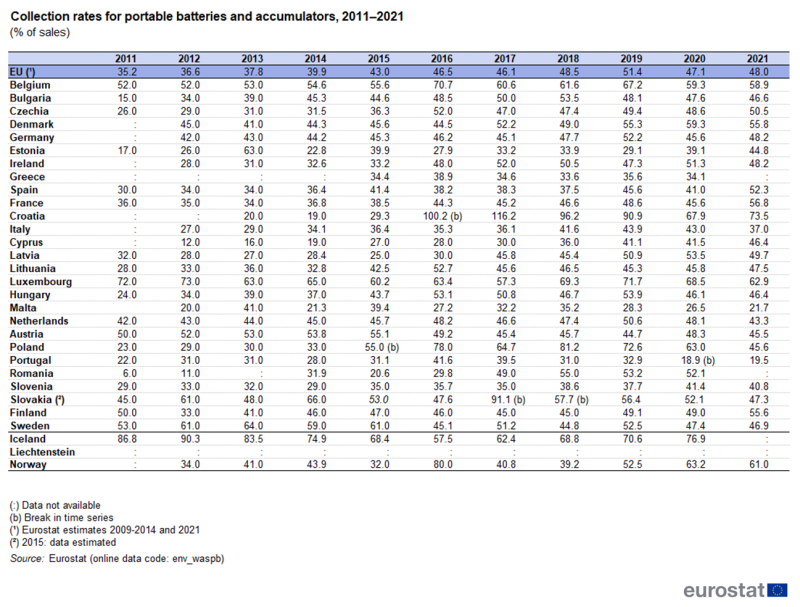
(%)
Source: Eurostat (env_waspb)
Recycling of batteries and accumulators
Due to the wide range of batteries that exist and the different type of metals and compounds of which they are made, there are specific recycling processes for each battery type. In this respect, the Batteries Directive differentiates between the type of applied technology based on lead-acid, nickel-cadmium (Ni-Cd) and other elements and compounds.
In contrast to sales and collection data, no distinction is made between portable and industrial / automotive batteries when it comes to recycling of batteries and accumulators. Thus, it is not possible to determine the type of batteries once they are shipped to the recycling facility. Consequently, the quantities of waste batteries and accumulators entering the recycling process are much higher than the recorded sales and collection amounts, which only include portable batteries and accumulators (see Tables 1a and 1b above and Tables 3a, 3b and 3c below).
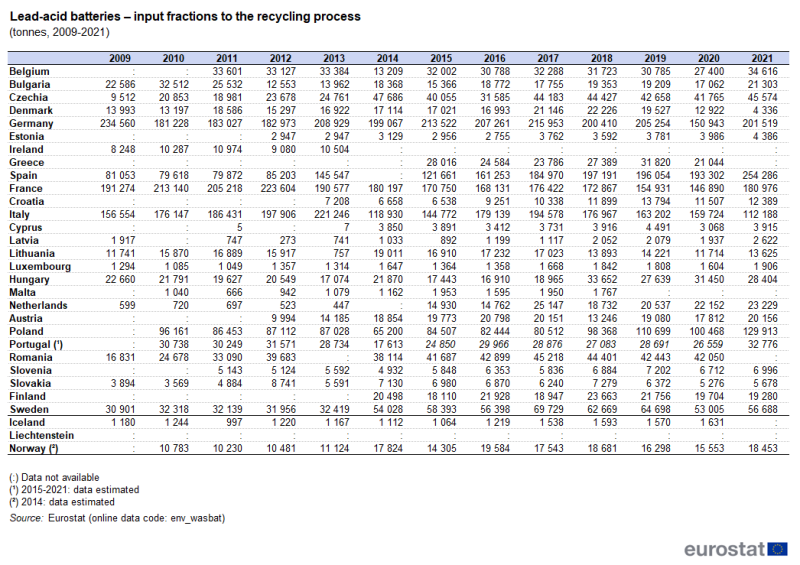
(tonnes)
Source: Eurostat (env_wasbat)
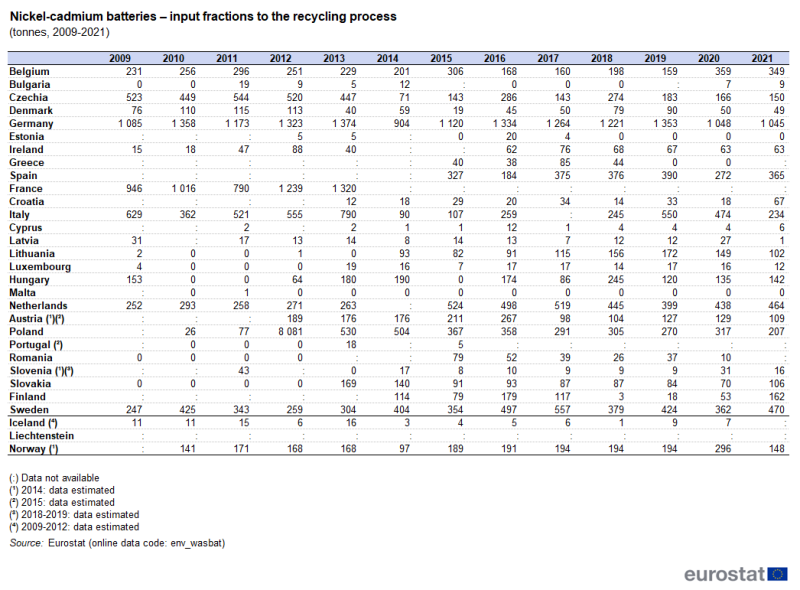
(tonnes)
Source: Eurostat (env_wasbat)
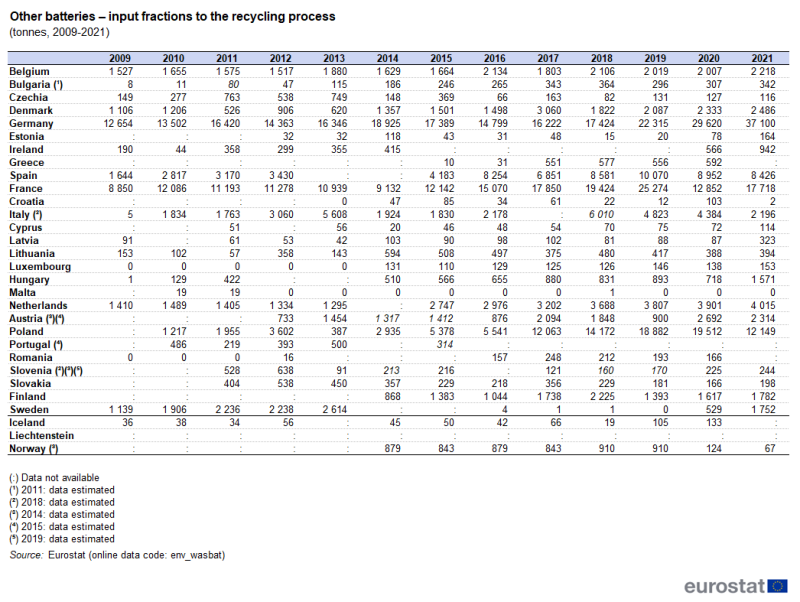
(tonnes)
Source: Eurostat (env_wasbat)
Recycling efficiency for lead-acid batteries
Recycling efficiencies for lead-acid batteries for reference years 2012 and 2021 are presented in Figure 2. In 2021, all EU Member States achieved the target of 65 % recycling efficiency for lead-acid batteries and accumulators.
It should be noted that for two Member States, Romania and Greece, data for 2021 are not yet available. In 2020, they reported a recycling efficiency of 90.9 % and 87.6 %, respectively.
Indeed, in 2021 all EU Member States reported recycling efficiencies of lead-acid batteries that were well above the target. Five Member States reported a recycling efficiency of more than 90 % and 13 a recycling efficiency in the range between 80 % and 90 %.
However, when comparing the recycling efficiencies for 2021 with those of 2012, there was no clear trend in the development of the recycling efficiency for lead-acid batteries and accumulators across the Member States. For 14 Member States, the recycling efficiency was lower in 2021 than in 2012. By contrast, the recycling efficiency was higher in 2021 than in 2012 for 13 Member States.

(useful recycled materials in % of input fractions)
Source: Eurostat (env_wasbat)
Recycling efficiency for Ni-Cd batteries
Recycling efficiencies for Ni-Cd batteries are presented in Figure 3. Most of the EU Member States achieved the recycling efficiency target of 75 % in both 2012 and 2021, with only a few exceptions. Among the 23 Member States for which 2021 data are available, all achieved this target. In comparison, of the 23 Member States for which data were available for 2012, 18 achieved the target.
The majority of the 22 Member States for which both 2021 and 2012 data are available recorded higher recycling efficiencies for Ni-Cd batteries in 2021 than in 2012. This was the case for 17 Member States. However, five of these Member States had reported a recycling efficiency of zero in 2012. By contrast, one Member State reported the same recycling efficiency in 2021 as in 2012, while four reported lower recycling efficiencies in 2021 than in 2012.

(useful recycled materials in % of input fractions)
Source: Eurostat (env_wasbat)
Recycling efficiency for other batteries
For other batteries, the recycling efficiency target of 50 % was reached by all reporting EU Member States in 2021 (see Figure 4) except one that reported zero. The recycling efficiencies for other batteries spanned from around 50 % to 88 % across the Member States for which 2021 data are available. This range is much wider than those for lead-acid batteries and for Ni-Cd batteries. In 2012, 18 of 22 Member States reported recycling efficiencies above the 50 % target.
Data for both 2021 and 2012 are available for 21 Member States. Among these, the recycling efficiencies for 'other batteries' were higher in 2021 than in 2012 for 14 Member States, while for seven Member States it was lower in 2021.
One factor behind the differences in recycling efficiencies for 'other batteries', over time and across Member States, may be that different types of batteries are more or less frequent among the 'other batteries' in different Member States or that this composition changes over time within the individual Member State.
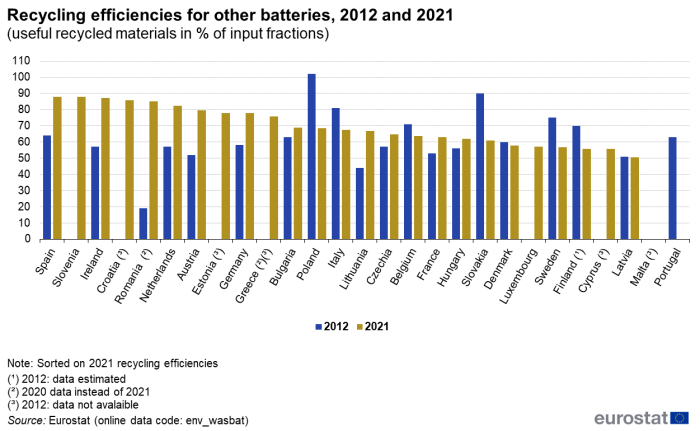
(useful recycled materials in % of input fractions)
Source: Eurostat (env_wasbat)
Source data for tables and graphs
Data sources
The reported data are available in Eurostat's reference database. Reporting generally started in 2012 and include reference years back to 2009.
The analysis generally focuses on the most recent data on sales, collection and recycling of batteries and accumulators (lead-acid, nickel-cadmium and others).
Definitions
The key definitions used in this article have been laid down by Directive 2006/66/EC on portable batteries and accumulators (the 'Batteries Directive'):
(1) Battery or accumulator means any source of electrical energy generated by direct conversion of chemical energy and consisting of one or more primary battery cells (non-rechargeable) or consisting of one or more secondary battery cells (rechargeable);
(2) Portable battery or accumulator means any battery, button cell, battery pack or accumulator that:
- is sealed; and
- can be hand-carried; and
- is neither an industrial battery or accumulator nor an automotive battery or accumulator;
(3) Automotive battery or accumulator means any battery or accumulator used for automotive starter, lighting or ignition power;
(4) Industrial battery or accumulator means any battery or accumulator designed for exclusively industrial or professional uses or used in any type of electric vehicle;
(5) Waste battery or accumulator means any battery or accumulator which is waste within the meaning of Article 1(1)(a) of Directive 2006/12/EC;
(6) Annual sales of portable batteries and accumulators to end-users should be expressed as the weight of the portable batteries and accumulators placed on the market in the territory of the Member State in the year concerned, excluding any portable batteries and accumulators that have left the territory of that Member State in that year before being sold to end-users;
(7) Placing on the market means supplying or making available, whether in return for payment or free of charge, to a third party within the Community and includes import into the customs territory of the Community;
(8) Collection rate means, for a given Member State in a given calendar year, the percentage obtained by dividing the weight of waste portable batteries and accumulators collected in accordance with Article 8(1) of this Directive or with Directive 2002/96/EC in that calendar year, by the average weight of portable batteries and accumulators that producers either sell directly to end-users or deliver to third parties in order to sell them to end-users in that Member State during that calendar year and the preceding two calendar years;
(9) Recycling efficiency of a recycling process means the ratio obtained by dividing the mass of output fractions accounting for recycling by the mass of the waste batteries and accumulators input fraction expressed as a percentage.
Context
The information and data presented in this article stem from the reporting obligations laid down in Directive 2006/66/EC on portable batteries and accumulators (the 'Batteries Directive' for short) and in Commission Regulation (EU) No 493/2012 laying down rules for calculation of recycling efficiencies for waste batteries and accumulators. The Batteries Directive sets collection targets for portable batteries and accumulators and recycling targets for all batteries and accumulators, differentiated by type.
Reliable and comparable data on the quantities of batteries and accumulators are necessary for monitoring whether the objectives of the Batteries Directive have been achieved. The Directive distinguishes between:
- portable batteries and accumulators; and
- industrial and automotive batteries and accumulators.
Member States report data on the sale and collection of portable batteries and accumulators and on the recycling of all batteries and accumulators. With regard to recycling, the Batteries Directive differentiates between the following three battery types:
- lead-acid batteries and accumulators,
- nickel-cadmium batteries and accumulators, and
- other batteries and accumulators.
Recycling efficiency
The Batteries Directive defines targets for the recycling efficiencies of batteries and accumulators. Recycling efficiencies address the recycling process only; they do not consider the efficiency of the collection, which is covered by the collection target for portable batteries and accumulators.
According to the Batteries Directive, recycling processes should achieve the recycling efficiencies:
- recycling of 65 % by average weight of lead-acid batteries and accumulators;
- recycling of 75 % by average weight of nickel-cadmium batteries and accumulators;
- recycling of 50 % by average weight of other batteries and accumulators.
Commission Regulation (EU) No 493/2012 specifies in Article 2 (3): 'recycling efficiency' of a recycling process means the ratio obtained by dividing the mass of output fractions accounting for recycling by the mass of the waste batteries and accumulators input fraction expressed as a percentage.
Starting with the reference year 2014, recycling efficiencies have to be calculated according to Commission Regulation (EU) No 493/2012. Details are given in Annexes I, IV, V and VI and in the Guidelines on the application of this Commission Regulation.
Direct access to
- Waste (env_was), see:
- Waste streams (env_wasst)
- Sales and collection of portable batteries and accumulators (env_waspb)
- Recycling of batteries and accumulators (env_wasbat)
- Waste streams (env_wasst)
- Sales, collection and recycling of portable batteries and accumulators (ESMS metadata file - env_waspb_esms)
- Waste statistics — Legislation
- Data for monitoring of compliance with targets
- Directive 2006/66/EC on portable batteries and accumulators
- Commission Regulation (EU) No 493/2012 laying down detailed rules regarding the calculation of recycling efficiencies of the recycling processes of waste batteries and accumulators
- Summaries of EU legislation: Disposal of spent batteries and accumulators
- European Commission – DG Environment: Waste and Recycling: Batteries